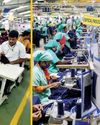
Even today, about 45% of its population is directly involved in the agricultural sector alone. As many as 42.3% of the country's workforce (in 2019-20), is directly employed in this sector. Two recent events - the Covid 19 pandemic and the ongoing geo-political problem in Europe has revealed the necessity of a vibrant agricultural sector in the country for economic stability.
India's agricultural status in the global perspective
India's agriculture covers 11.24% of the total arable land of the world. It has 4% of the world's renewable resources. As of 2020, India feeds about 18% of the world's population which is about 1.38 billion.
Ashok Gulati, Infosys Chair professor at ICRIER and Ritika Juneja, fellow at ICRIER (Indian Council for Research and International Economic Relations) in their research article published a few months ago named 'Indian Agriculture Towards 2030', pointed out many interesting data.
How did India achieve self-sufficiency in food production? The reason is simple. Between 1980-81 and 2019-20, the sector registered an annual growth rate of 3.2%. In that period, India's population growth was 1.7% per annum - a rate that was half of the agricultural food production growth rate. This helped India achieve self-sufficiency in food production. At the same time, labour productivity in agriculture is low. India produces about 16.5% of its GDP with the engagement of 42.3% of the country's workforce. Most of the holding size is very small. The average size of the land holding is 1.08 hectare (in 2015-16).
Esta historia es de la edición February 1 - 28, 2023 de BUSINESS ECONOMICS.
Comience su prueba gratuita de Magzter GOLD de 7 días para acceder a miles de historias premium seleccionadas y a más de 9,000 revistas y periódicos.
Ya eres suscriptor ? Conectar
Esta historia es de la edición February 1 - 28, 2023 de BUSINESS ECONOMICS.
Comience su prueba gratuita de Magzter GOLD de 7 días para acceder a miles de historias premium seleccionadas y a más de 9,000 revistas y periódicos.
Ya eres suscriptor? Conectar

Bank of Baroda, Kolkata Zone organised Mega Kisan Melas in West Bengal
Bank of Baroda (BOB) organised Mega Kisan Mela at Konkalitala in Birbhum District of West Bengal on November 18, 2024 as a part of the 7th Edition of the Baroda Kisan Pakhwada (BKP).

Time-Bound Disposal of Cases to Expedite the Delivery of Justice and affordabe by all in India
The delay in the disposal of cases in Indian courts remains a significant hurdle to the nation's progress.

Dev Deepawali: A grand celebration of light, spirituality, and culture in Varanasi
The holy city of Varanasi, often regarded as India's spiritual and cultural heart, came alive with the splendor of Dev Deepawali on the sacred day of Kartik Purnima.

The life of Job 'Ye judge not the judgment of God' - Jesus Christ
The Holy Bible reveals through the life of Job how the Lord tests the righteous and that faith helps one to overcome life's adversities.

India has the highest potential for the garment industry, only a conducive government policy is required.
India's textile industry is poised for remarkable growth, with expectations to double its contribution to the GDP within the next six to seven years.

Global Public Debt may be worse than it appears, warns IMF
Global Public Debt Set to Exceed $100 Trillion, Warns IMF

The economic consequences of Trump's Presidency: A global perspective
One of the key economic factors contributing to the Democrats' loss in the US elections was the significant rise in inflation, which was initially triggered by the COVID-19 pandemic and exacerbated by the Russia-Ukraine war.

Challenges and Successes in West Bengal's Education Sector: A Comprehensive Overview
The education system in West Bengal, particularly in districts, villages, slums, and government institutions, reflects a blend of progress and ongoing challenges.

What India can expect from Trump's return
I may be too early to predict how Donald Trump's second term as president will impact the global oil market.

Stocks Surge Following Donald Trump's Election as 47th President of the USA
Stocks soared following the election of Donald Trump as the 47th President of the United States. Investors anticipated that the Information Technology (IT) sector would benefit from lower corporate taxes under the Republican regime, with IT stocks leading the rally.